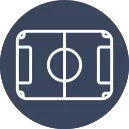Sports fields are special engineered play surfaces developed to provide a safe, consistent and low maintenance connection between athlete or performer and the ground. They vary from neighborhood pitches to professional stadiums and must adhere to rigorous standards of play, longevity and player welfare. If fields are properly constructed and maintained, consistent use of them can be maintained throughout seasons and injury risks are minimized.
Surface Types
Various sports and budgets demand different field surfaces.
1. Natural Grass
Natural grass provides a traditional appearance, soft feel underfoot and classic appeal.
- It offers zero padding that more and more athletes like.
- It’s shock-absorbent and can help cut down on joint stress.
- It requires regular watering, mowing, fertilizer and managed drainage to thrive.
- Heavy use or adverse weather can make bare patches or muddy areas.
2. Synthetic Turf
The synthetic grass surface provides a consistent year round, all- weather pitch product.
- It relies on plastic fibers and an infill of rubber or sand to help simulate real grass.
- It’s durable against heavy use and doesn’t get patchy.
- It also slashes water use and mowing costs.
- Under direct sun, it can feel warmer and cooling measures might be in order in extremely hot climates.
3. Hybrid Systems
Hybrid systems blend natural grass with synthetic fibers for strength and playability.
- A few percent of the total area are made of synthetic fibres that are stitched into the grass layer.
- This serves to bind the turf together, so that it is even more wear-resistant than pure grass.
- It keeps the natural appearance and feels of live grass.
- Installation and maintenance are more expensive than grass alone.
Design and Construction
Constructing a sports field requires sound planning in order to have a long life and deliver optimum playability.
Site Assessment
All good design begins with the land.
- Soil tests verify composition, compaction and drainage capability.
- Aspects related to deposition site, such as sunlight, natural curvature and barriers in the vicinity, affect the field orientation.
- Regional climate dictates whether it is best to use grass or turf.
Drainage and Irrigation
Water management also plays a role in maintaining the field as playable both in wet and dry conditions.
- Surface runoff structures and soft grades (1–2%) convey stormwater rapidly.
- Underground tubes and gravel beds keep the underside of the turf from getting waterlogged.
- And automated irrigation systems provide plants with just the right amount of water, so no waste ensues and roots stay healthy.
Base and Sub-Base Preparation
The playing area and its occupants are supported via a base.
- Native soil may be separated from fill by a geotextile fabric to prevent mixing.
- Crushed stone footing is compacted under the stair treads to form a strong base.
- The specific thickness of each layer will vary based on the type of surface selected and the amount of traffic anticipated.
Installation Process
Installation approaches will be slightly different by surface type but generally follow best practices.
Natural Grass Installation
Grass fields may be matured by either seed or sod.
- Seeding endless possibilities, allow to find the grass variety that meets the local conditions. It takes time to get established and needs to be carefully watered though!
- Sodding gives an immediate playing surface with increased material and labor costs.
- After seeding or sodding, the first watering and a little light rolling can aid roots to level.
Synthetic Turf Installation
Artificial grass installation requires careful trimming and infilling.
- Turf is unfurled, cut to the shape of the field and seamed together.
- Infill materials (rubber, sand or, less commonly, organic materials) are combined with the fibers to provide blade upright structure and bolstering.
- Edges are fastened down with pegs or adhesive to prevent the turf from becoming ruffled under heavy use.
Line Marking and Accessories
The boundary and gear establish playing area and safety.
- They are painted on grass or heat-bonded strips on turf for long-term visibility.
- Goals and nets and benches and padding must all conform to sport-specific dimensions and safety guidelines.
- Well-placed lighting and seating add to the spectator experience without impacting the quality of play.
Maintenance and Care
Regular maintenance is what keeps sports fields safe, looking good and playable. This section separates chores by monthly and seasonal routine, and includes a highlight of necessary power equipment.
Regular Maintenance
Tasks that are perennial keep minor issues from exploding into major issues.
- Even grass fields need to be mowed to the right length, aerated to reduce compaction, fertilized to support healthy turf.
- Artificial turf fields need to be brushed or groomed to straighten the fibers as well as shuffle and remove infill and debris.
- Inspections find worn spots, drainage problems or safety hazards before they deteriorate.
Seasonal Maintenance
Special care for each season.
- Spring: Oversowing empty patches with seed and topdressing grass fields in the spring to recover winter damage.
- Summer: Modified irrigation and mowing heights as needed to address heat stress.
- Autumn: Clear leaves and feed so grass can rebound before winter.
- Winter: Little to no mowing for grass, and occasional snow removal or protective covers for grass and turf fields.
Equipment and Tools
The proper tools make maintenance easier, safer and more effective.
- Aerators, rollers and top dressers are tending the health of the grass.
- Power brushes and sweepers maintain standing and cleanliness of synthetic turf fibers.
- Lightweight, portable line-striping machines can expedite the task of marking.
Safety and Performance Standards
Having certified standards also means that the game will be played more fairly, with a decrease in injuries. This area will have main authorized qualifications and testing way.
Safety Certifications
Satisfactory standards ensure that surfaces behave as expected.
- Shock absorption tests determine how much impact the surface mitigates, to cushion players who land hard.
- Traction tests make sure athletes can change direction without slipping.
- Scratch tests determine how well the surface can withstand multiple uses without scratching easily.
Performance Testing
Periodic testing confirms that fields are performing within the acceptable range.
- Ball roll and ball bounce tests are used to examine if the surface plays a role in game dynamics.
- Friction tests confirm that the shoes grip well on grass and turf.
- One need to test fields once they are installed and to ensure that certifications remain in tact.
Sustainability and Environmental Impact
Contemporary field management is aiming at reducing resource consumption and waste. This portion focuses against water savings and recycle prospects.
Water Conservation
Conserving water helps the environment and operating costs.
- Artificial turf requires no watering.
- Soil moisture- and weather-based smart irrigation controllers for grass fields.
- Drought-tolerant strains of grass may also need less water.
Recycling and Waste Reduction
Using recycled materials lowers the overall footprint of a sports field.
- Recycled tire crumb rubber infill promotes recycling while extending the life of the turf.
- Grass clipping composting not only returns nutrients to the soil but also decreases landfill garbage.
- Regrinding or reusing the old turf fibers reduce the amount of the fiber in landfills.
Conclusion
A properly designed and maintained field ensures safe play, minimizes injuries and provides optimal performance. With a knowledge of the best fit and demands of each surface type and in accordance with design and maintenance best practices, and the environment that surrounds it, companies can choose and maintain fields that suit the needs of athletes and communities for many years.




